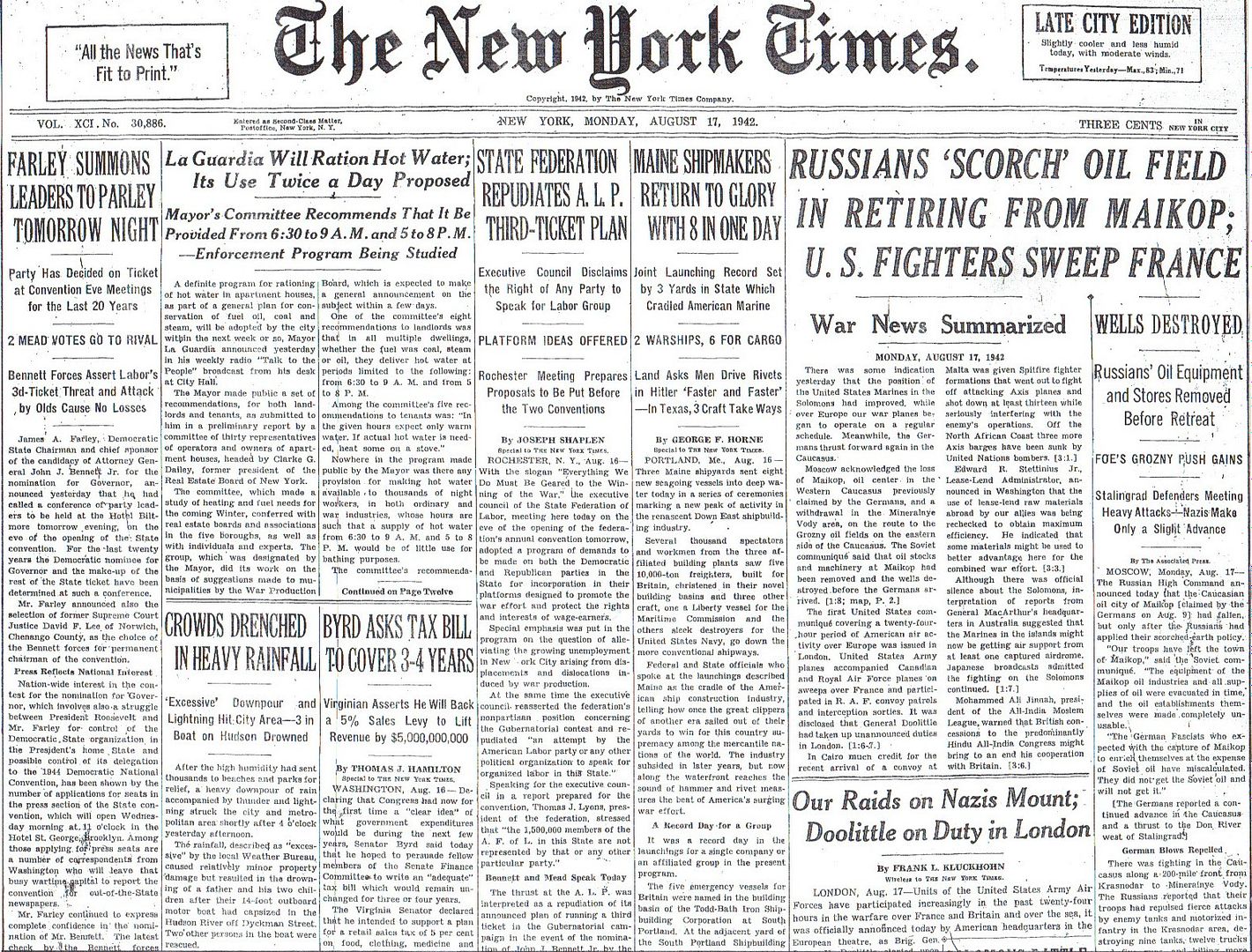
Posted on 08/17/2012 4:45:03 AM PDT by Homer_J_Simpson

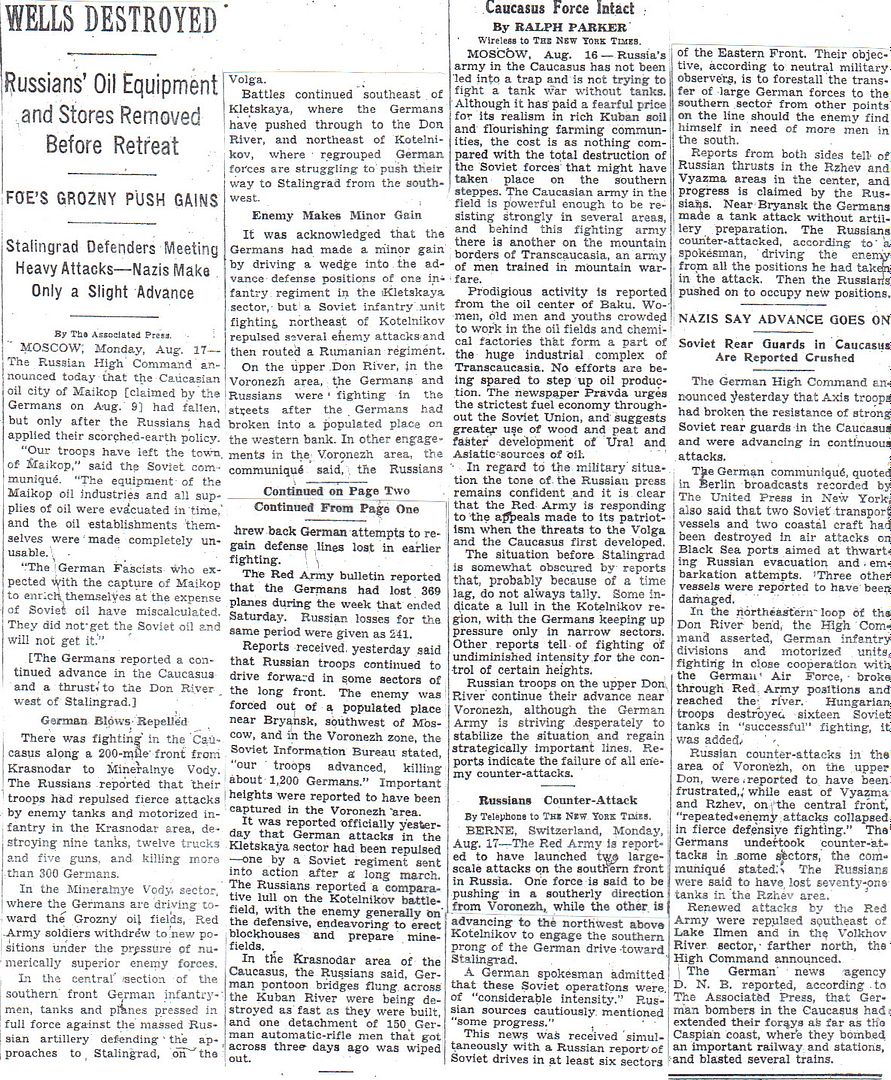
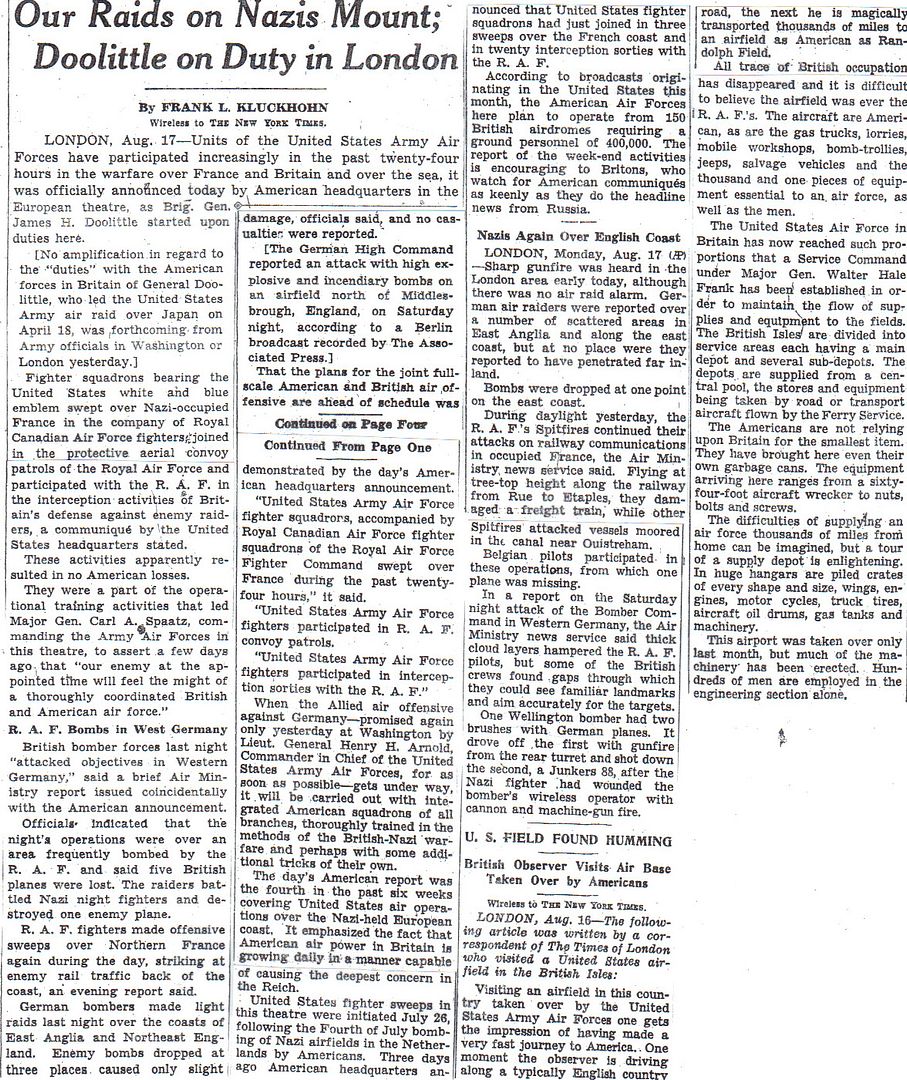
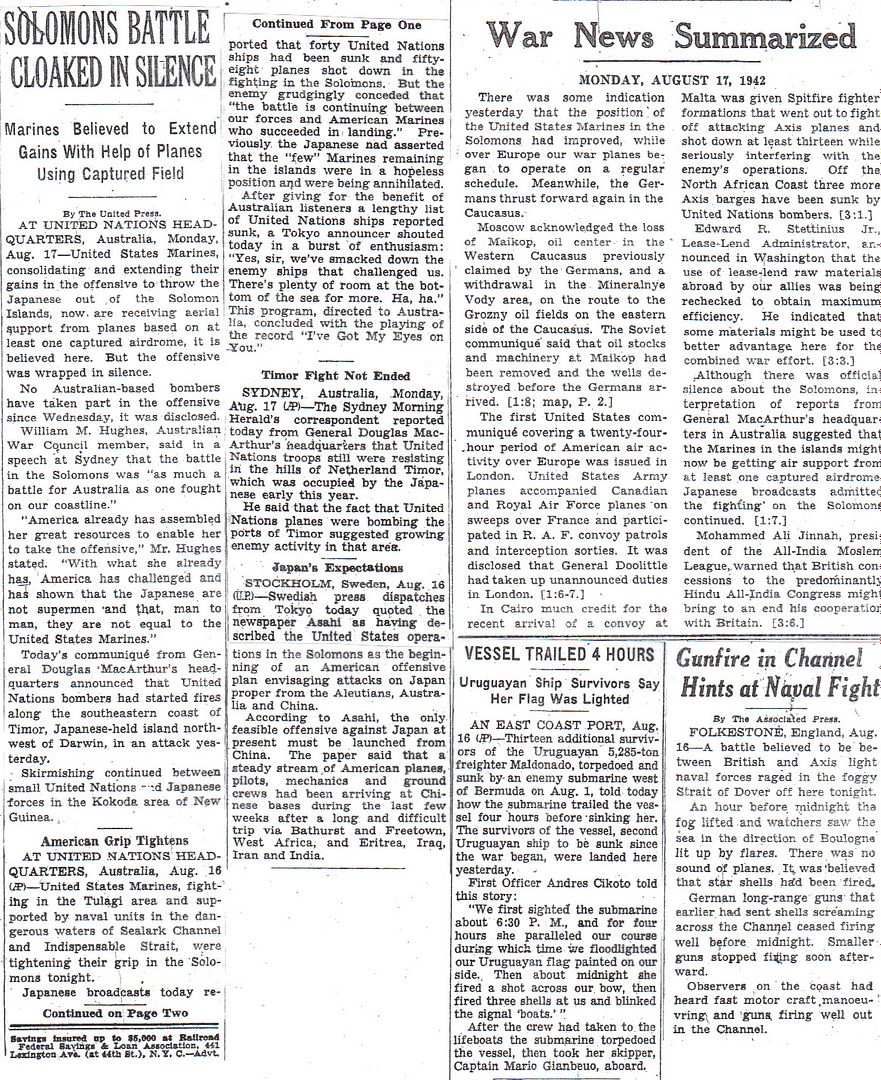
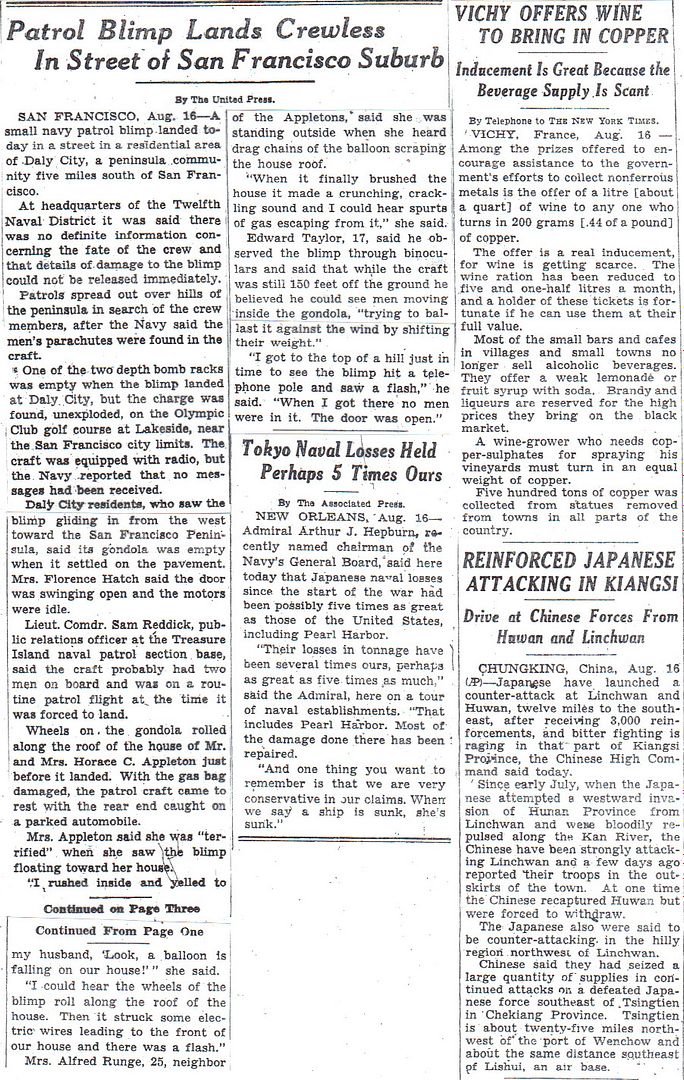

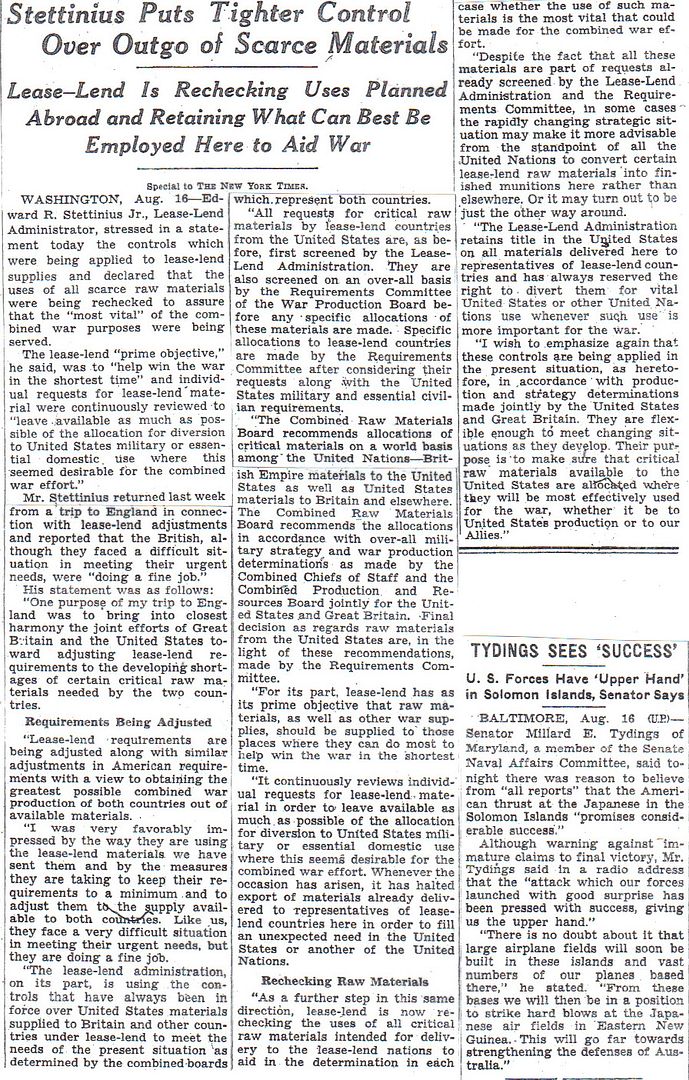

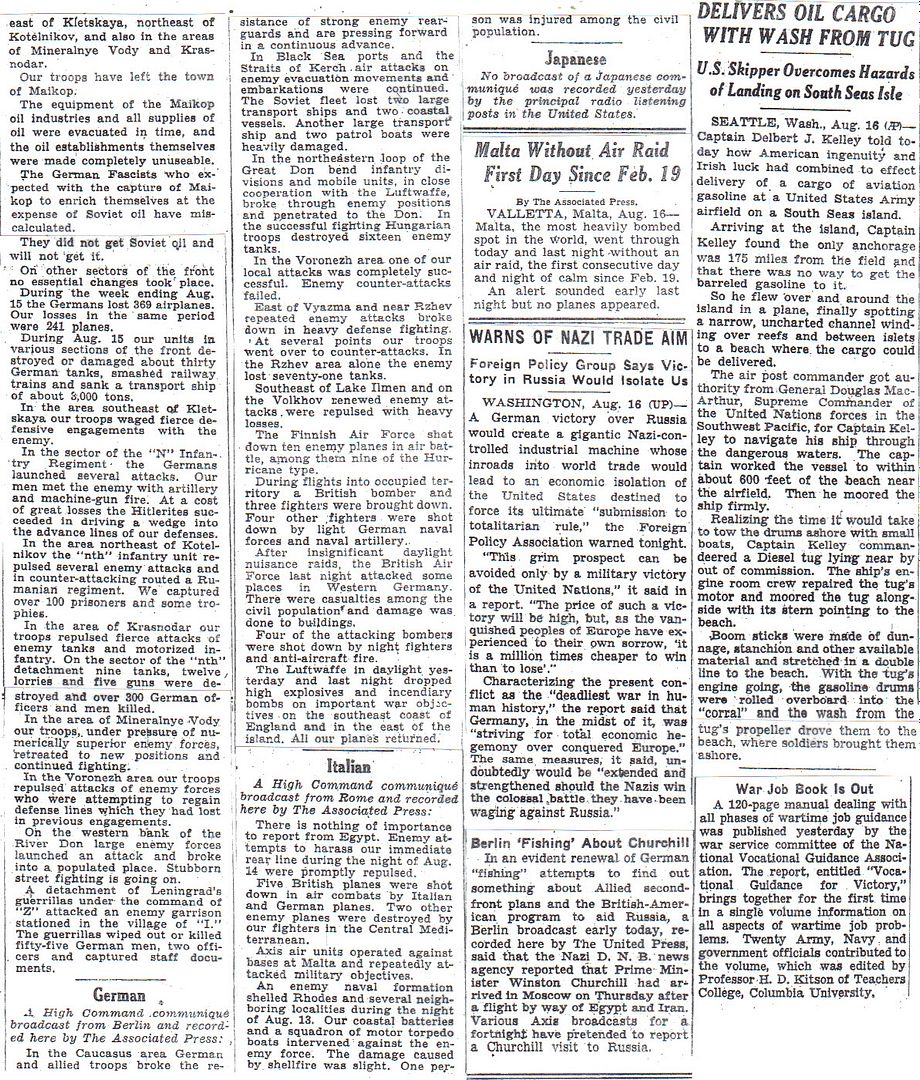
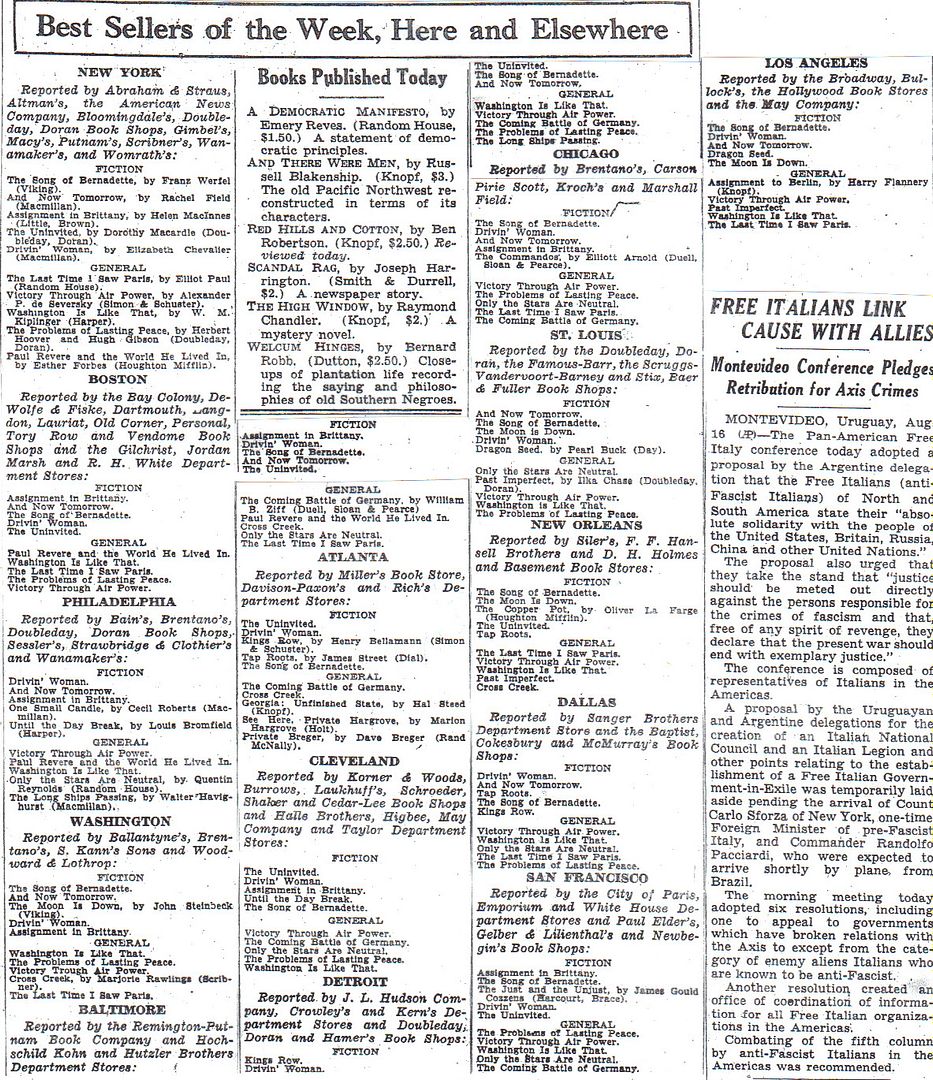
Wells Destroyed (Parker) – 2
Our Raids on Nazis Mount; Doolittle on Duty in London (Kluckhohn, on overseas assignment) – 3
Solomons Battle Cloaked in Silence – 4
War News Summarized – 4
Patrol Blimp Lands Crewless in Street of San Francisco Suburb – 5-6
The Texts of the Day’s War Communiques – 8-9
Best Sellers of the Week, Here and Elsewhere * – 10
* Quarterly feature to follow evolution of American reading habits. “The Song of Bernadette,” “Assignment in Brittany,” “The Uninvited,” and “King’s Row” are doing well this quarter in the fiction category. “The Coming Battle of Germany” makes a few of the the general lists. I wonder what that is about. Here are the earlier lists. They are near the end of the post in each case.
5/18/42 Thread
2/16/42 Thread
11/17/41 Thread
8/18/41 Thread
5/19/41 Thread
2/17/41 Thread
11/18/40 Thread
8/19/40 Thread
5/13/40 Thread
2/19/40 Thread
10/23/39 Thread
http://www.onwar.com/chrono/1942/aug42/f17aug42.htm
Germans advancing in Caucasus
Monday, August 17, 1942 www.onwar.com
German infantry in the Caucasus [photo at link]
On the Eastern Front... The important power stations at Pyatigorsk and Yessentuki, in the Caucasus are captured by German forces.
In the Gilbert Islands... US Marines stage a raid on a Japanese seaplane bases on Makin Island.
Over Occupied France... The first bombing raid flown by a completely American squadron bombs Rouen in France.
http://homepage.ntlworld.com/andrew.etherington/frame.htm
August 17th, 1942
UNITED KINGDOM: First use of the Moonshine radar countermeasures system which allowed a single aircraft to simulate a much larger force. Installed in obsolete Defiant aircraft, the system is used to protect a US 8th A/F raid on French railway yards in Rouen with great success. (Cris Wetton)
Light cruiser HMS Blake laid down. Minesweeping trawlers HMS Promise and Prodigal commissioned.
The Canada Steamship Lines merchantman Kindersley (1,999 GRT) was damaged by bombs from Luftwaffe aircraft in the North Sea, off Blyth. There is no record of casualties in this incident. (Dave Shirlaw)
FRANCE : Rouen is the target for the First all-American bombing raid over Europe.
The USAAF’s VIII Bomber Command in England flies Mission 1. Twelve B-17E Flying Fortresses of the 97th Bombardment Group (Heavy) based at Grafton Underwood, Northamptonshire, takeoff at 1527 hours. The lead aircraft of the first flight of six is named “Butcher Shop” and is piloted by Colonel Frank A. Armstrong, the group commander; the co-pilot is Major Paul W. Tibbets, the pilot of the B-29 “Enola Gay” which dropped the first atomic bomb on Hiroshima in August 1945. The lead aircraft of the second group is “Yankee Doodle” and this aircraft carries Major General Ira C. Eaker, Commanding General, VIII Bomber Command. The B-17s rendezvous with four squadrons of RAF Spitfire Mk. IXs and proceed to the target, the Sotteville marshalling yard at Rouen France. A second diversion force of six B-17s took off at 1512 hours from Polebrook, Northamptonshire, headed for France but then turned around and returned to base. All 12 aircraft bomb at 1739-1746 hours; the bombing was reasonably accurate with about half the bombs falling in the general target area. The escorts kept Luftwaffe fighters at bay but one Bf 109 got within range and was claimed as damaged by a ball turret gunner. The main force returns to base shortly after 1900 hours. (Jack McKillop)
They fly at high altitude in daylight escorted by RAF, Dominion and Allied fighters. Despite being attacked by Messerschmitt Me109s they all returned safely and one gunner shot down a German fighter.
Brigadier-General Ira C. Eaker, the commander of the USAAF Bomber Command, led the attack which followed hard on the pledge by Major-General Carl Spaatz, the commander of the USAAF in Europe, to inflict “very powerful Anglo-American air blows on the enemy.”
Major-General Spaatz was at the airfield to greet the crews on their return. “They behaved like veterans,” he said, “this is the real start of our bombing effort and we are going to keep it up.” The Flying Fortress crews were jubilant about their raid. One pilot said: “We have broken the ice at last. This is what we had been waiting for. The big moment came when, at great altitude, we saw the targets, an important marshalling yard and railway terminus with roundhouses to accommodate 250 locomotives. To see all the bombs making dead hits was like all the Fourths of July I have ever known.”
This attack not only marked the entry of the USAAF heavy bombers into the war over Europe; it gave the American aviators the opportunity to test their theories of daytime precision bombing under war conditions. They believe that their Fortresses, bristling with half-inch machine guns, can beat off fighters by the defensive fire of their high altitude formations. The RAF having suffered heavy daytime bombing losses, is sceptical.
GERMANY: U-720 laid down. (Dave Shirlaw)
U.S.S.R.: The Germans cross the Kuban river and capture Russian positions and vital power stations, in Pyatigorsk and Yessentuki in the Caucasus.
Black Sea Fleet and Azov Flotilla: Shipping loss: MS “TSch-405 “Vzrivatel”” - by field artillery, close to Eupatoria (later raised) (Sergey Anisimov)(69)
Soviet submarine Shch-307 is also lost, mined near Suuraari Island. (Mike Yared)(146 and 147)
U-209 sank SS Kompleks, SS Komsomolec and escorts P-4 and SH-3. (Dave Shirlaw)
MEDITERRANEAN SEA: The Italian transport Nino Bixio is torpedoed and sunk by a British submarine. She was carrying Allied POWs and 117 New Zealanders die. (Jack McKillop)
The Canadian Pacific Railways passenger liner Princess Marguerite (5,875 GRT), Captain Leicester, Master, was torpedoed and sunk in the Mediterranean Sea in position 32.03N, 032.47E, by U-83, Kptlt Hans-Werner KRAUS, Knight’s Cross, CO. Princess Marguerite was requisitioned by the British Government at the end of 1941 from CPR Ships for use as a troopship. After a refit in Esquimalt, she was dispatched to the Mediterranean. Princess Marguerite was enroute to Cyprus, escorted by the armed merchant cruiser HMS Antwerp and three destroyers, with elements of the British 8th Army embarked, when she was torpedoed. A fuel oil fire rapidly spread out of control and detonated a magazine. The ship sank in less than an hour. The loss of life would have been much greater had it not been for the determined efforts of the destroyer HMS Hero (later HMCS Chaudiere), who rescued a great number of the survivors. In all, 55 souls were lost in this incident. (Dave Shirlaw)
GILBERT ISLANDS: Makin Island: Companies “A” and “B,” 2d Marine Raider Battalion (Lieutenant Colonel Evans F. Carlson, USMC), land on Butaritari Island. The purpose of this raid is to destroy Japanese installations, take prisoners, gain intelligence on the area and divert Japanese attention and reinforcements from the Solomon Islands; Intelligence estimates that there are 45 Japanese on the island. The Marines had been transported in the submarines USS Nautilus (SS-168) and USS Argonaut (SS-166), each of which could carry a company. The submarines surfaced in heavy rain and high seas and Carlson changed the plans; originally, the two companies were to land on widely separated beaches but the new plan has them landing together. One platoon did not get the word and ended up landing alone in what became the enemy rear.
The two companies crossed the island and then turned southwest towards the known Japanese positions and a fire fight soon ensued. The Japanese launched two banzai attacks which were easily dispatched; unknown to the Americans, these attacks nearly wiped out the Japanese garrison.
At 1130 hours, two enemy aircraft appeared and they dropped bombs, none of which hit the Marines. Two hours later, 12 aircraft appeared, several of them seaplanes. Two large seaplanes landed in the lagoon and were fired upon by the Marines; one burst into flames and the other crashed on takeoff. The remaining aircraft bombed and strafed the island for an hour.
The natives on the island reported that Japanese reinforcements had landed from the seaplanes and two small ships in the lagoon. Colonel Carlson believed there was a sizeable Japanese force on the island and it was decided to evacuate the troops in their rubber boats. However, a heavy surf soaked the outboard engines making them inoperative, boats capsized and equipment was lost. Several boatloads of troops made it to the submarines but Carlson and 120 men ended up on the shore where they remained into the next day. (Jack McKillop)
BISMARCK ARCHIPELAGO: A single USAAF B-17 of the Allied Air Forces bombs Kavieng, New Ireland Island.
NEW GUINEA: 24 IJN bombers attack Seven-Mile Aerodrome at Port Moresby and destroy 3 B-26 Marauders and a transport.
TERRITORY OF ALASKA: In the Aleutian Islands, a US 11th Air Force B-24 Liberator flies photo reconnaissance over Buldir, Kiska and Amchitka Islands despite heavy rain.
U.S.A.: Destroyer USS Anthony laid down. Minesweeper USS Motive launched.
Movie star Clark Gable goes to OCS. (Stuart Kohn)
ATLANTIC OCEAN: U-108 torpedoes and sinks the armed U.S. merchant tanker SS Louisiana about 200 miles (322 km) off Paramaribo, Dutch Guiana, in position 07°24’N, 52°33’W; although the crew of the U-boat sees three men escape from the burning ship, they are never found. There are no survivors from the 41 merchant sailors and the 8-man Armed Guard. (Jack McKillop)
U-507 sank SS Arará and SS Itagiba.
U-566 sank SS Triton in Convoy SL-118.
U-658 sank SS Fort la Reine, SS Samir and damaged SS Laguna in Convoy PG-6.
The Canadian-built, British-registered cargo ship Fort la Reine (7,130 GRT), Captain Percy W. Pennock, Master, was sunk by U-658, Kptlt Hans Senkel, Knight’s Cross, CO, in the Windward Passage, NE of Jamaica, in position 18.30N, 075.20W. Fort la Reine was as part of the 23-ship Vancouver, British Columbia, to Liverpool (via Cristobal, Guantanamo Bay, and Halifax) convoy PG-6 when she was lost. The was loaded with 9,800 tons of grain, lumber and other general cargo. The Master, 37 crewmembers and three DEMS gunners were rescued by the Flower-class corvette HMS Pimpernel. Twelve other survivors were rescued by a USN patrol boat. One DEMS gunner and two crewmembers were lost in this incident. Fort la Reine was a North Sands-class freighter built by Burrard Drydock Company Ltd. (South Yard), at Vancouver, British Columbia She was completed in Jul 42. Fort la Reine was one of 90 North Sands-class freighters built in Canada for American order under the Hyde Park Declaration and subsequently provided to Great Britain under the Lend-Lease Agreement. J. Constantine & Sons Ltd., of Middlesborough, England, managed the ship for the British government. Twenty-two of these ships were sunk and another seven were damaged.
Submarine USS Bass while at sea, a fire broke out in the after battery room and quickly spread to the after torpedo room and starboard main motor, resulting in the death of 25 enlisted men by asphyxiation. The following day USS Antaeus arrived to assist the submarine and escorted her into the Gulf of Dulce, Costa Rica. Both vessels then proceeded to Balboa. (Dave Shirlaw)
This might have far-reaching consequences upon the Allied conduct of the war. The British-Soviet positions in Northern Persia would collapse, and the southern supply route for American military aid to Stalin—by way of the Persian Gulf, the Caspian, and up the Volga—would be severed.
Even the bold plan of directing Rommel's Africa Corps via Egypt into Mesopotamia would enter the realm of the possible.
At that time the men of the German-Italian Panzer Army in Africa were standing at El Alamein, at the gates of Cairo, after their brilliantly fought pursuit during the late summer of 1942. The sappers were already calculating the number of bridging columns they would need for crossing the Nile, and whenever a trooper was asked, "Where's our next stop?" he would frivolously reply, "Ibn Saud's palace."
These fantastic long-range objectives were exceedingly popular among the men of Ruoff's combat group. As soon as the formations of XLIX Mountain Corps heard that they were moving into the Caucasus they too coined their slogans.
In his book Mountain Jägers on All Fronts Alex Buchner reports the answer of a Jäger to the question about the purpose and objective of the long trek through the steppe:
"Down the Caucasus, round the corner, slice the British through the rear, and say to Rommel, 'Hello, General, here we are!' "
Towards the end of August 1942 the divisions of V Corps began their attack against Novorossiysk, the first major naval fortress on the eastern coast of the Black Sea. Novorossiysk, which had 95,000 inhabitants at that time, was an important harbor and industrial town with extensive cold-storage plants and shipbuilding yards, with a large fish-processing industry and cement-mills.
The 125th and 73rd Infantry Divisions fought their way forward through the foothills of the Caucasus to the approaches of the town. Quite suddenly before them they saw the sea.
Colonel Friebe, commanding 419th Infantry Regiment, on catching sight of the sea-coast from some high ground, ordered the old Greek tag to be radioed to his neighbor, Colonel Reinhardt of 421st Infantry Regiment: "Thalassa, thalassa-the sea, the sea!"
With these words, according to the ancient Greek historian Xenophon, the Greek vanguards, 2400 years before, had hailed the sea when they first caught sight of it after their arduous retreat through the waterless deserts and mountains of Asia Minor, when they reached the coast near Trebizond, exactly opposite Novorossiysk.
But a great deal of hard and costly fighting was needed before the regiments of 125th and 73rd Infantry Divisions gained control of Novorossiysk, which was being stubbornly defended by units of the Soviet Forty-seventh Army. On 6th September 1942 the 1st Battalion, 186 Infantry Regiment, under Lieutenant Ziegler launched its assault against the port and harbor at the head of 73rd Infantry Division. By 10th September the town and its surroundings were firmly in German hands. The first objective of Ruoff's Army-sized combat group had been reached.
The next objective was Tuapse—a keypoint in the narrow coastal plain.
Tuapse became a turning-point in the destinies of List's Army Group.
In addition to V Infantry Corps, XLIV Jäger Corps, and LVII Panzer Corps, Seventeenth Army also included XLIX Mountain Corps, with its 1st and 4th Mountain Divisions, as well as the Rumanian 2nd Mountain Division. There was a special purpose behind this combination of infantry, Jägers, and mountain troops.
While General Wetzel's infantry divisions were taking Novorossiysk by frontal attack across the wooded foothills of the north-western Caucasus, the 97th and 101st Jäger Divisions, advancing behind LVII Panzer Corps via Maikop, were already fighting their way across the "Wooded Caucasus" towards the port of Tuapse. These Jäger divisions were experts in operating in hilly country. General Konrad's mountain Jägers, on the other hand, were to drive across the 10,000 to 14,000 feet high passes of the Central Caucasus towards the Black Sea coast, bursting in, as it were, through the back door. Their objective was Sukhumi, the palm-lined town on the sub-tropical coast and capital of the Abkhaz Autonomous Soviet Socialist Republic. Many holiday dachas for Soviet leaders, including Stalin, were situated here. From there it was about 100 miles to the Turkish frontier at Batumi.
Behind advanced motorized combat groups of the SS Panzer Grenadier Division "Viking" and the Slovak Fast Division, General Konrad's mountain Jägers on 13th August mounted their attack from the steppe against the high passes of the Caucasus—the 4th Mountain Division on the right, to gain the passes in the headwaters region of the Laba river, the 1st Mountain Division on the left, to charge over the mountain passes along the glaciers of Mount Elbrus, where the Kuban river has its source. The most important crossing was the Klukhor Pass, 9230 feet high, the starting-point of the old Sukhumi Military Highway.
In the sector of 1st Mountain Division Major von Hirschfeld made a rapid dash with the 2nd Battalion, 98th Mountain Jäger Regiment, as far as the entrance to the pass, which was barricaded and defended by strong Russian forces. The position could not be taken by frontal assault. But von Hirschfeld gave the Russians a demonstration of German mountain warfare.
While cleverly deceiving the enemy by engaging him frontally, he outflanked the pass by negotiating the sheer sides of the mountains, and presently rolled up the Soviet positions from the rear. The highest point of the Sukhumi Military Highway was in German hands by the evening of 17th August.
Quick as lightning Major von Hirschfeld continued his dash into the Klydzh Valley, took the village of Klydzh at the foot of the mountains, and thus found himself in the middle of the luxuriant forests of the Black Sea coast. One last leap, and the coastal plain would be gained.
But a surprise advance into the plain was not to be accomplished with the weakened forces. The Russians were furiously and stubbornly defending the exit from the mountains. Sukhumi, the great objective, was a mere 25 miles away. But Major von Hirschfeld, far ahead of the bulk of his forces, with a mere handful of men entirely self-dependent, was in a dangerous position. On his left flank was a big void; Kleist's Panzer Army was still in the steppe, north of Mount Elbrus.
Faced with this situation, General Konrad decided upon a bold operation in order to cover the Corps' left flank. Captain Groth, with a high alpine company composed of mountain guides and climbers, was given the task of getting into the Mount Elbrus passes, which were over 13,000 feet high, and of cutting off the Baksan Valley from where the Russians were threatening the German flank.
This was probably the most spectacular battlefield of the war.
Deeply creviced, the sheer faces of rust-red porphyry dropped precipitously over several thousand feet from the rocky mass of Mount Elbrus. The distant ice-fields of the great Asau Glacier glistened in the sun—ice-falls, cleft rocks, and vast expanses of scree.
Over the savage mountain fighting for the former Tsarist hunting-lodge of Krugozor, situated at an altitude of nearly 10,000 feet over the deep cleft of the Baksan Valley, towered Mount Ushba, 15,411 feet high, and one of the most beautiful mountains in the world. It was topped only by Mount Kazbek, farther east on the Georgian Military Highway, and by the twin peaks of Mount Elbrus.
Naturally enough, the men of 1st Mountain Division, in whose line of advance Mount Elbrus was situated, wanted to conquer the giant mountain. Such an operation, of course, was of no military value, but the world might prick up its ears if German troops planted the swastika on the highest mountain in Europe.
General Konrad therefore authorized the proposed climb.
He made it a condition, however, that the ascent should be made jointly by men of 1st and 4th Divisions. It was a wise decision: it avoided wounding the mountaineering pride of 4th Division.
The expedition was led by Captain Groth.
The participants from 4th Mountain Division were under the command of Captain Gammerler. The climbers had a curious surprise very early in the proceedings. First Lieutenant Schneider had set out from the base camp with his signals party ahead of the bulk of the climbers, because the heavy signals equipment they were carrying would later be bound to slow them down. A long way ahead, on the far side of the huge glacier, the men saw the fantastic Intourist House which the Soviets had erected at an altitude of 13,800 feet—a massive oval shape of concrete, without any kind of ledge or projection, entirely clad with aluminum sheeting. It looked like a gigantic airship gondola.
There were forty rooms with sleeping accommodation for a hundred people in that amazing glacier hotel. Above it was a meteorological station, and below the main structure was the kitchen building.
Schneider and his party made fast progress over the snow of the glacier, which had not yet been softened by the day's sunshine. Suddenly, through his binoculars, he spotted a Soviet soldier in front of the house.
"Careful," Schneider called out to his men.
He made them turn off the direct route and bypass the hotel. Among the rocks above the building they took up battle positions. Just then Captain Groth came trudging along, all alone. Before it was possible to warn him the Russians had him covered.
The Soviet garrison consisted of only three officers and eight men. They had come up only that morning.
Groth instantly grasped the situation and kept his head. One of the Russian officers spoke German: to him Groth explained the hopelessness of their situation. He pointed to the German rope parties approaching in the distance and to the signals platoon which had taken up positions among the rocks. In this way he eventually persuaded the Soviets to withdraw voluntarily. Four of the Red Army men, however, preferred to stay with Groth and await the arrival of the bulk of the German climbing party in order to offer their services as porters.
The following day, 18th August, was declared a day of rest. The mountain Jägers were to get acclimatized to the altitude. On 19th August the assault on the summit was to start. But the plan was foiled by a sudden blizzard. On 20th August heavy thunderstorms with gusts of hail kept the men again at the Mount Elbrus house.
On 21st August at last a brilliantly sunny morning promised a fine day. They had set out at 0300 hours—Captain Groth with sixteen men and Captain Gammerler with five. By 0600 hours the fine weather was at an end. A Föhn came up from the Black Sea. Fog, and later a snowstorm, defended the peak of the giant mountain. In a small refuge Groth and Gammerler stopped with their men for a break. Should they return again? No—the mountain Jägers wanted to go on.
On they went. The climb in the rarefied air and the biting cold became an eerie race. The men's eyes were caked with snow. A gale was howling over the icy flank of the ridge. Visibility was barely 10 yards. By 1100 they had conquered the ice-slope. Captain Gammerler stood at the highest point of the ridge. In front of him the ridge began to drop again. Clearly he was on the summit.
Sergeant Kümmerle of the 1st Mountain Division rammed the shaft of the Reich War Flag deep into the soft snow. Then the standards of 1st and 4th Mountain Divisions with the edelweiss and the gentian were thrust into the ground. A brief handshake and the party quickly climbed into the eastern face where the force of the westerly gale was somewhat diminished. Presently an amazed world was told that the swastika was flying from the highest peak in the Caucasus.
The conquest of Mount Elbrus by German mountain Jägers, a successful climb of a mountain entirely unknown to them, and in appalling weather, was an outstanding mountaineering feat. It is not made any less remarkable by the fact that a few days later, when the weather had cleared, Dr Riimmler, a special correspondent with the Corps, discovered that the flags had been planted not at the trigonometric point of the highest peak, but on an eminence of the summit ridge about 130 feet below the main summit. In the fog and icy blizzard of 21st August the mountain Jägers had mistaken that point for the actual summit.
To return to the fighting in the mountain passes. While the battalions of 1st Mountain Division were forcing their way through the Klukhor Pass and along the old and dilapidated Sukhumi Military Highway, always within sight of the 18,480-foot peak of Mount Elbrus, Major-General Eglseer took his 4th Mountain Division from Austria and Bavaria through the high-level passes of the main range.
Colonel von Stettner with the 1st and 3rd Battalions, 91st Mountain Jäger Regiment, gained the Sancharo and Alustrakhu Passes at altitudes between 8500 and 10,000 feet. The main range of the mountains had thus been crossed, and the further advance now was downhill towards the passes of the foothills and into the sub-tropical forests of the Sukhumi area.
Major Schulze with the 3rd Battalion, 91st Mountain Jäger Regiment, stormed through the Bgalar Pass, and thus found himself immediately above the wooded slopes dropping steeply towards the coastal plain. The coast, the great objective, was a mere 12 miles away.
The Jägers had covered more than 120 miles of mountains and glaciers. With exceedingly weak forces they had fought engagements at altitudes of nearly 10,000 feet, overwhelming the enemy, charging vertiginous rocky ridges and windswept icy slopes and dangerous glaciers, clearing the enemy from positions considered impregnable. Now the men were within sight of their target. But they were unable to reach it.
Von Stettner's combat group had only two guns with twenty-five rounds each at its disposal for the decisive drive against the coast. "Send ammunition," he radioed.
"Are there no aircraft?
Aren't the Alpini coming with their mules?"
No—there were no aircraft.
As for the Alpini Corps, they were marching to the Don, towards Stalingrad.
Colonel von Stettner, the commander of the gallant 91st Mountain Jäger Regiment, was in the Bzyb Valley, 12 miles from Sukhumi. Major von Hirschfeld was in the Klydzh Valley, 25 miles from the coast.
Major-General Rupp's 97th Jäger Division had fought its way to within 30 miles of Tuapse. Included in this division were also the Walloon volunteers of the "Wallonie" Brigade under Lieutenant-Colonel Lucien Lippert.
But nowhere were the troops strong enough for the last decisive leap. Soviet resistance was too strong. The attacking formations of Army Group A had been weakened by weeks of heavy fighting, and supply lines had been stretched far in excess of any reasonable scale. The Luftwaffe had to divide its forces between the Don and the Caucasus. Suddenly the Soviet Air Force controlled the skies. Soviet artillery was enjoying superiority. The German forces lacked a few dozen fighter aircraft, half a dozen battalions, and a few hundred mules. Now that the decision was within arm's reach these vital elements were missing.
It was the same as on all other fronts: there were shortages everywhere. Wherever operations had reached culmination point and vital objectives all but attained, the German Armies suffered from the same fatal shortages. Before El Alamein, 60 miles from the Nile, Rommel was crying out for a few dozen aircraft to oppose British air power, and for a few hundred tanks with a few thousand tons of fuel. In the villages west of Stalingrad the assault companies of Sixth Army were begging for a few assault guns, for two or three fresh regiments with some anti-tank guns, assault engineers, and tanks. On the outskirts of Leningrad and in the approaches of Murmansk —everywhere the troops were crying out for that famous last battalion which had always decided the outcome of every battle.
But Hitler was unable to let any of the fronts have this last battalion.
The war had finally grown too big for the Wehrmacht.
Everywhere excessive demands were being made on the troops, and everywhere the fronts were dangerously over-extended.
The battlefields everywhere, from the Atlantic to the Volga and the Caucasus, were haunted by the spectre of impending disaster.
Where would it strike first?
Way to go Hitler! Sort of nice to read first hand accounts of the consequences of Hitler's strategic blunders.
The Fuhrer's initial joy at Maikop's seizure was shared by many of his cohorts.
According to Ciano's diary, Mussolini "attributes a great deal of importance" to its capture. It will have the effect, the Italian foreign minister wrote. "of relieving the Axis, but not immediately, and not altogether of the pressing oil problems.
However, their delight soon turned to bitter disappointment when they learned that Soviet rear guards had already destroyed hundreds of wells, wrecked oil storage facilities, and crippled the refineries by removing vital components. Although this was always a likely result the damage was far more extensive than the Axis leaders had naively hoped. Twelve days after the city fell, the inspector or air defenses reported that only two oil wells were "capable of being developed for use. One well is still burning, although it may soon be possible to extinguish the fire. The other wells have been rendered useless by having cement poured down the bores. The Soviets had also destroyed the large refinery in Krasnodar, he added.
Bringing Maikop back into production would be difficult and time-consuming.
At the end or August. Georg Thomas head of the War Economy and Armaments Office, noted in his monthly situation report that "only insignificant amounts or mineral oil were found" when Maikop fell.
The extensive damage inflicted on extraction and processing installations and the sporadic fighting still taking place in the region made it impossible at the moment to conduct a through investigation of the oil field. Yet only after specialists conducted such an investigation Thomas pointed could they determine how soon and to what degree the field could be exploited.
On 8 September-that is, a month after German troops first entered the Maikop oil field, choking on thick smoke billowing from burning storage tanks Dr. Schlicht of the Mineralol Brigade reported to Thomas on progress at Maikop. Difficult terrain-"extremely suitable for partisan warfare" -prevented the transportation of cumbersome drilling equipment, at least until new transportation routes could be created.
In the meantime Schlicht said German specialists had to determine which wells would be easiest to unblock. This would not be simple; the Soviets had inflicted massive damage, even to pipelines. "Until now," he emphasized,"only 4.000 cubic meters of oil stocks have been uncovered.
It will take at least another six months until regular production can resume:' Accordingly "It is essential we give the Reichsmarschall (Goring. still plenipotentiary of the Four-Year Plan and in effect, Germany's economics dictator] a completely accurate picture of Maikop:' Goring's understanding of the situation, he added. was grossly over-optimistic: "Questions are already being raised about whether the southern army groups can now be supplied with fuel directly from Maikop."
Schlicht was right: Goring’s grasp of matters relating to oil production was extremely weak. For instance, two months later, on 21 November, he presided over an oil conference in Berlin. Maikop. which had yet to produce oil for Axis troops (and never would, except a few dribbles), remained at the forefront of his mind. "I'm fed up!" he exclaimed. "Months have passed since we captured the first oil wells, yet we still aren't getting any benefit. He astounded his audience of technical experts when, referring to the concrete plugs dropped down the bores, he naively demanded to know: "Can't you just drill them out with something like a gigantic corkscrew?"
"Glimpsing freedom and safety ahead, Jewish refugees cross over the border into Switzerland.
Few were so fortunate as this group since the Swiss, citing their need to protect their neutrality, turned a cold shoulder toward most refugees, especially Jews.
One official referred to his country as a 'crowded little lifeboat,' and in 1942 the Swiss government instructed border officials to turn back refugees at the French border, essentially dealing death sentences to Jews."
Disclaimer: Opinions posted on Free Republic are those of the individual posters and do not necessarily represent the opinion of Free Republic or its management. All materials posted herein are protected by copyright law and the exemption for fair use of copyrighted works.